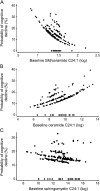A lipid storage-like disorder contributes to cognitive decline in HIV-infected subjects
- PMID: 24027056
- PMCID: PMC3888167
- DOI: 10.1212/WNL.0b013e3182a9565e
A lipid storage-like disorder contributes to cognitive decline in HIV-infected subjects
Abstract
Objective: In this multicenter cohort study, we sought to identify prognostic and associative metabolic indicators for HIV-associated neurocognitive disorders (HAND).
Methods: A quantitative lipidomic analysis was conducted on 524 longitudinal CSF samples collected from 7 different performance sites across the mainland United States, Hawaii, and Puerto Rico. Subjects included HIV-infected individuals with longitudinal clinical and cognitive testing data and cognitively normal HIV-negative healthy controls.
Results: At baseline, HIV+ subjects could be differentiated from HIV- controls by reductions in a single ceramide species and increases in multiple forms of cholesterol. Perturbations in cholesterol metabolism and ceramide were influenced by combined antiretroviral therapy (cART) use. There were no cross-sectional baseline differences in any lipid metabolite when HIV+ subjects were grouped according to cognitive status. However, a single sphingolipid metabolite and reduced levels of esterified cholesterols were prognostic indicators of incident cognitive decline. Longitudinal patterns of these disturbances in sphingolipid and sterol metabolism suggest that a progressive disorder of lipid metabolism that is similar to disorders of lipid storage may contribute to the pathogenesis of HAND.
Conclusions: These findings suggest that HIV infection and cART are independently associated with a CNS metabolic disturbance, identify surrogate markers that are prognostic for cognitive decline, and implicate a lipid storage-like disorder in the progression of HAND.
Figures



Comment in
-
Lipids and cognition make good bedfellows for neuroAIDS.Neurology. 2013 Oct 22;81(17):1480-1. doi: 10.1212/WNL.0b013e3182a958ba. Epub 2013 Sep 11. Neurology. 2013. PMID: 24027058 No abstract available.
References
-
- Brodt HR, Kamps BS, Gute P, Knupp B, Staszewski S, Helm EB. Changing incidence of AIDS-defining illnesses in the era of antiretroviral combination therapy. AIDS 1997;11:1731–1738 - PubMed
-
- Sacktor N, Lyles RH, Skolasky R, et al. HIV-associated neurologic disease incidence changes: multicenter AIDS cohort study, 1990-1998. Neurology 2001;56:257–260 - PubMed
-
- McArthur JC, Steiner J, Sacktor N, Nath A. Human immunodeficiency virus-associated neurocognitive disorders: mind the gap. Ann Neurol 2010;67:699–714 - PubMed
Publication types
MeSH terms
Substances
Grants and funding
- U54NS43011/NS/NINDS NIH HHS/United States
- HHSN271201000027C/MH/NIMH NIH HHS/United States
- AA0017408/AA/NIAAA NIH HHS/United States
- U54 RR026139/RR/NCRR NIH HHS/United States
- U24 MH100928/MH/NIMH NIH HHS/United States
- U54 MD007587/MD/NIMHD NIH HHS/United States
- U54 NS043011/NS/NINDS NIH HHS/United States
- R01 MH077542/MH/NIMH NIH HHS/United States
- HHSN271201000030C/MH/NIMH NIH HHS/United States
- AG034849/AG/NIA NIH HHS/United States
- 1U54RR026139-01A1/RR/NCRR NIH HHS/United States
- MH071150/MH/NIMH NIH HHS/United States
- N01 MH022005/MH/NIMH NIH HHS/United States
- 8U54MD007587/MD/NIMHD NIH HHS/United States
- R01 MH061427/MH/NIMH NIH HHS/United States
- DA61427/DA/NIDA NIH HHS/United States
- S11NS46278/NS/NINDS NIH HHS/United States
- P30 MH075673/MH/NIMH NIH HHS/United States
- MH22005/MH/NIMH NIH HHS/United States
- R21 AG034849/AG/NIA NIH HHS/United States
- U54 NS056883/NS/NINDS NIH HHS/United States
- NS56883/NS/NINDS NIH HHS/United States
- U01 MH083506/MH/NIMH NIH HHS/United States
- R01 AA017408/AA/NIAAA NIH HHS/United States
- MH075673/MH/NIMH NIH HHS/United States
- MH61427/MH/NIMH NIH HHS/United States
- R01 MH071150/MH/NIMH NIH HHS/United States
- MH077542/MH/NIMH NIH HHS/United States
LinkOut - more resources
Full Text Sources
Other Literature Sources
Medical
